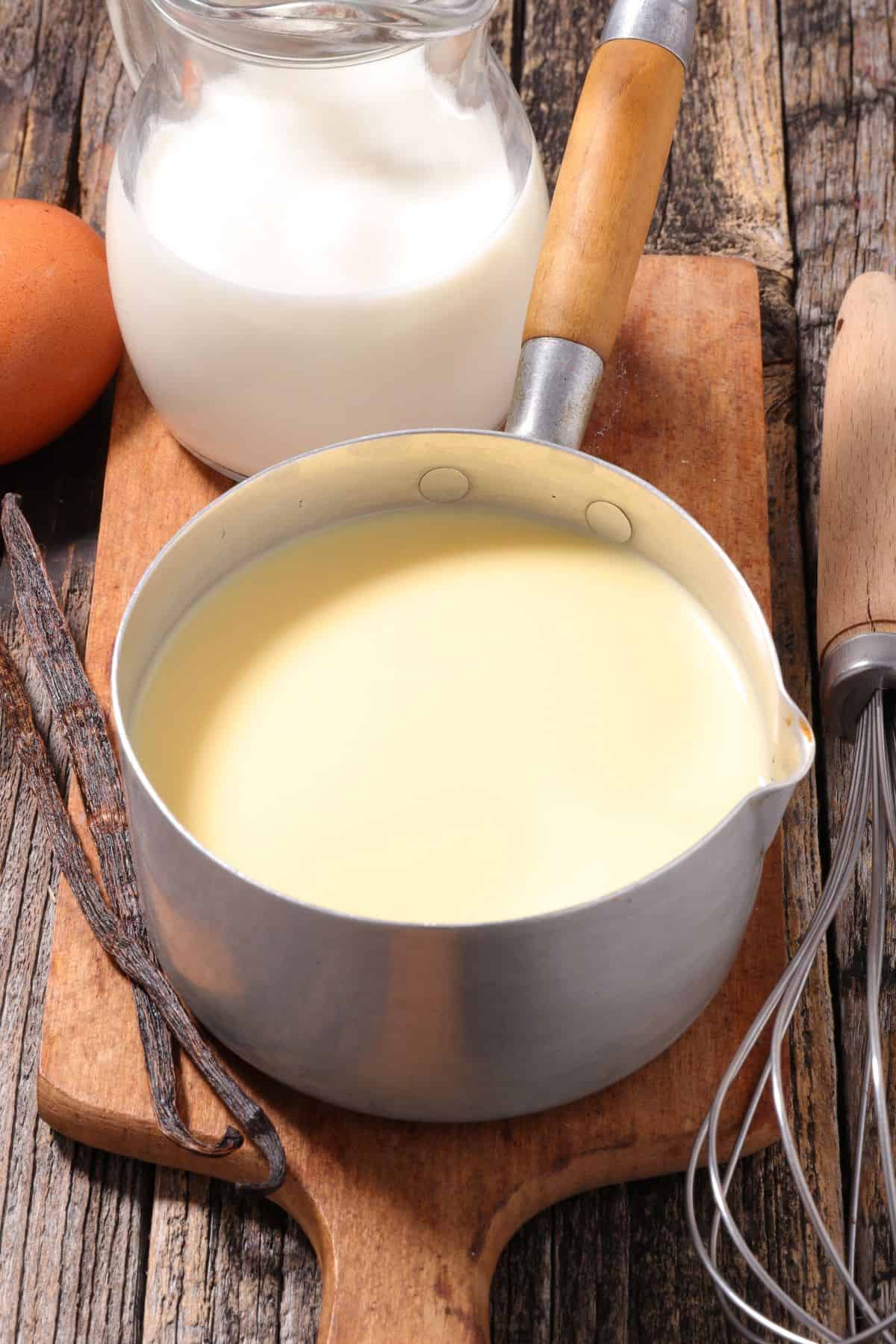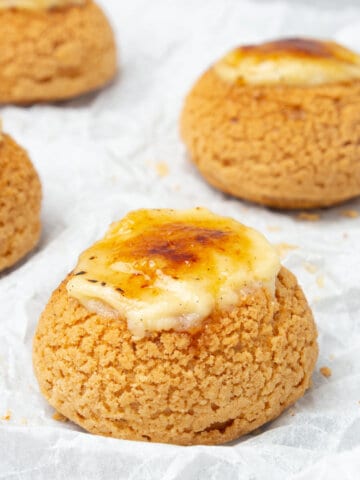If you've ever asked yourself, "what is custard?" this guide will break down everything you need to know about the delicious treat as well as several ways to use it as a part of your next kitchen adventure.
From frozen custard to pastry cream, the custard definition spans a wide variety of food. You may have the base knowledge that custard is a silky, smooth dairy-based dessert. However, understanding the specifics of how to define custard, what is custard made of, and what is custard used for can greatly enhance your culinary prowess.

Jump to:
What is Custard?
Custard, in a broader term, is a variety of culinary preparations. It is typically a sweet cream, sauce, filling, or dessert that forms from a mixture of eggs (typically egg yolks, rather than egg whites) and either milk or cream, sometimes flour, starch, or gelatin. Custard takes the form of a wide range of desserts, and it can also be the base of savory dishes, like hollandaise sauce.
The history of custard is as rich as the food itself, with the origin of custard dating back several centuries to the Middle Ages. Even during these ancient times, people paired egg custard with pastries to make custard tarts.
What is Custard made from?
Custard is always made with an egg base. Additionally, custard comes together with the addition of liquid dairy or other similar non-dairy liquids like coconut milk or almond milk, as well as sugar to sweeten your dessert custards.
You will also sometimes include a thickening agent in your custard base. The use of these custard ingredients depends on the texture you’re trying to achieve. For example, there are thicker custards that use cornstarch and flour, like pastry cream, and thinner custards that just rely on egg yolks, like creme anglaise.
Finally, vanilla is the most common flavoring for custards, but you can also use chocolate, coffee, and practically any spice imaginable.

Types of Custard
There are two main classifications of custard: stirred custards and baked custards.
Stirred custards cook in a saucepan on the stove and retain a thinner consistency unless thickened with starch or flour. After cooking, it can be further you can further enrich the cream with butter, whipped cream, etc. Examples include lemon curd, pastry cream, creme mousseline, diplomat cream, bavarian cream, and creme anglaise.
Baked custards have a thicker consistency than their stirred counterparts. You will sometimes bake these in a water bath in order to help achieve a creamy and delicate consistency. Examples of baked custards include cheesecakes, clafoutis, creme brulee, and quiches.
How to make Custard
If you’ve ever wondered how is custard made, there are several methods, but they boil down to either stirring it on a stovetop or baking it in an oven. One of the greatest things about custard is that the definition is so broad that there is no one specific way to make it. The process of how custard is made really depends on the variation of custard you’re making.
Below I will walk you through step-by-step how to make creme anglaise, as this is a good general base to understand for preparing custard.
1. In a large bowl, whisk together sugar and egg yolks until fluffy. Add vanilla extract.
2. Bring milk to simmering in a saucepan on medium heat. Pour the warm milk over the egg yolk mixture, whisking vigorously and continuously to temper the egg yolks without cooking them.
3. Pour the mixture back into the saucepan and cook at medium heat until the mixture slightly thickens and ites temperature reaches 82C / 180F.
4. Remove the cream from the stove as soon as the cream reaches the desired temperature. Do not cook it further as the mixture will curdle.
5. Allow the cream to cool completely before using.
You can also bake certain custards, like creme brulee and clafoutis, or they may involve cooking using a double boiler method. Still, they often include a similar overall process to the one described here.

Custard Desserts
There are so many popular desserts with custard as a major component. You can also use custard as a filling or a frosting, or it can be a dessert on its own. Here are some of my favorite custard desserts:
Crème Pâtissière: You can use this authentic French pastry cream for filling your cakes, donuts, cream puffs, and more.
Diplomat Cream: Also called Bavarian Cream (incorrectly, see next one), this lighter version of French pastry cream adds whipped cream to give it a lighter and fluffier texture.
Bavarian cream: Bavarian cream is a Creme Anglaise based dessert that is thickened with gelatin and whipped heavy cream. Can be used to fill cakes and donuts or frost cupcakes or pasties.
Crème Anglaise: Use this vanilla custard sauce on pancakes, pastries, or even as a drinking custard.
Floating Island: Made with milk, sugar, egg, and vanilla (effectively Creme Anglaise with egg white clouds floating on it) the floating island dessert isn't just simple to make but also gluten-free!
Charlotte Cake: Made with layers of ladyfingers, creme mousseline, and strawberry coulis, this is a wonderfully elegant ladyfinger dessert.
Mille-Feuille: Similar to a Napolean, this sophisticated dessert features a classic vanilla bean pastry cream and layers of airy puff pastry.
Pumpkin Custard Pie: This is the most delicious pumpkin pie, hands down! The combination of flaky, buttery pie crust and silky, creamy, incredible delicious pumpkin custard flavored with aromatic orange zest and nutmeg will blow your mind!
Lemon Meringue Tart: This is just one of the many custard pies you can make with an egg yolk base. My Strawberry Custard Pie is another must-try!
Lemon Curd: An extremely versatile custard that makes a rich and tangy filling for everything from macarons to cupcakes.
Flourless Chocolate Cake: This baked chocolate custard is one of the most popular gluten-free desserts.
Eclair or Cream puff: Choux pastry is crispy on the outside and filled with velvety pastry cream, you'll often notice a shiny ganache finish on these elegant desserts.
Creme Caramel: Also known as flan, this silky smooth treat is one of the most classic caramel desserts.
Crème brûlée: This delicious dessert features a creamy vanilla custard topped with a layer of caramelized sugar.
How to store Custard
An egg and dairy mixture makes up the base of custard dishes. Because of this, the safest place to store everything from your leftover pastry cream to uneaten eclairs is in the refrigerator.
Leaving these treats at room temperature for extended periods of time encourages bacteria growth that can make you sick. It’s best to keep leftover custard refrigerated and, if necessary, warm it up when you’re preparing to enjoy it again.
Custard FAQ
When you overcook custard, it can curdle and/or become very thick and might even break and gets runny. It can also develop a rubbery texture. Make sure to always follow the recipe when it comes to how long to cook the custard to avoid these mistakes.
When comparing custard vs ice cream, it’s easy to overlook the differences. The main distinction is that custard has egg yolks, while traditional ice cream is typically just milk, cream, and sugar. Frozen custard also has a denser texture in part because its churning does not incorporate much air into the dessert.
If you’re wondering what is a custard vs a pudding, it’s more subtle than you might think. While custard and pudding are closely related, the main difference is that custard traditionally uses just eggs as a thickening agent while classic pudding includes the addition of starches to thicken it. Custard is also usually a firmer, more stable, and more versatile dessert than pudding. However, many use these two phrases interchangeably, that is incorrect as you can see in many ways.
Is there egg in custard? Yes, unless you’re making it from custard powder. Custard from powder provides a quick way to make a custard-based sauce or filling for a pie. If you’re wondering what is custard powder made of, it contains flour, milk powder, thickening agents, and flavoring.
While you can view custard powder as a faster, egg-free alternative, the flavor will not be as high quality. It more closely mimics a vanilla sauce similar to pudding.
Custard is delicious cream on its own or a delicious base for many other creams and desserts. Try eating custard with ice cream, fruit, waffle, pancake, pie and so on.
Custard Recipes

What is Custard
Equipment
- Digital scale
Ingredients
- 250 g (1 cups) Whole Milk 3% fat
- 40 g (⅕ cups) Granulated sugar
- 60 g (¼ cups) Egg yolk approx. yolk of 3 eggs
- 2 teaspoon Vanilla extract
US customary cup measurement is an indicative figure only. Measure the ingredients with a digital scale by weight (gram). Baking is art but also science which requires precision and accuracy.
Instructions
- As you have learned in this article, Custard, in a broader term, is a variety of culinary preparations. It is typically a sweet cream, sauce, filling, or dessert that forms from a mixture of eggs (typically egg yolks, rather than egg whites) and either milk or cream, sometimes flour, starch, or gelatin. Below, I will walk you through step-by-step on a base custard cream recipe, for more custard recipes visit the Note section of this recipe card or the body of this article.
- In a large bowl, whisk together sugar and egg yolks until fluffy. Add vanilla extract.
- Bring milk to simmering in a saucepan on medium heat. Make sure it is simmering but not boiling.
- Pour the warm milk mixture over the egg yolk mixture slowly while whisking vigorously and continuously to temper the egg yolks without cooking them.
- Pour the mixture back into the saucepan and cook on medium heat until temperature reached 82C / 180F.
- Remove the cream from the stove as soon as cream reaches the desired temperature. Do not cook it further as the mixture will curdle.
- Use the custard according to the recipe. Any leftovers can be refrigerated for 2-3 days.









Lynne
Thank you for the detailed recipe. I made custard for years and tasted a custard at a dinner party and it was fabulous. I have been trying to remake that custard for years now and when I saw your recipe, I tried it. I was overcooking my custard and it was always dreadful. Your recipe is almost foolproof and so easy and versatile! I am in love again with custard. Thank you for sharing!!!!